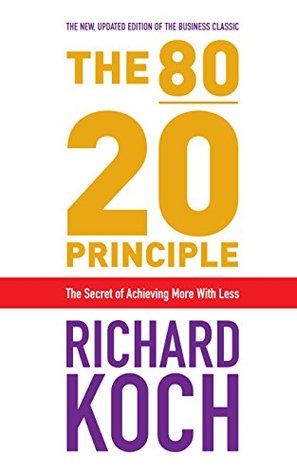More on this book
Community
Kindle Notes & Highlights
by
Richard Koch
Read between
June 25, 2018 - November 23, 2019
wonky!
combustion
80/20 Principle was discovered in 1897 by Italian economist Vilfredo Pareto (1848–1923).
consistent mathematical relationship between the proportion of people
and the amount of income or wealth that this group enjoyed.
pattern of imbalance was repeated consistently whenever he looked at data referring to different time periods or different countries.
philology,
There seems to be a natural, almost democratic, expectation that causes and results are generally equally balanced.
‘50/50 fallacy’ is one of the most inaccurate and harmful, as well as the most deeply rooted, of our mental maps.
disparity
substitution.
Resources that have powerful effects are used as much as possible.
mimic
arbitrage.
‘trivial
If we did realize the difference between the vital few and the trivial many in all aspects of our lives, and if we did something about it, we could multiply anything that we valued.
illuminate
linear;
‘But never read a book from cover to cover, except for pleasure. When you are working, find out what the book is saying much faster than you would by reading it through. Read the conclusion, then the introduction, then the conclusion again, then dip lightly into any interesting bits.’ What he was really saying was that 80 per cent of the value of a book can be found in 20 per cent or fewer of its pages, and absorbed in 20 per cent of the time most people would take to read it through.
Don’t apply 80/20 Analysis in a linear way
The key consideration is not the distribution of books sold, but what customers want.
20 per cent of titles that generate 80 per cent of profits.
‘best sellers represent about 5% of total sales’.
salutary.
When using the 80/20 Principle, be selective
contrarian.
The most valuable insight from 80/20 Analysis will always come from examining non-linear relationships that others are neglecting.
Most important decisions have never been made by analysis and never will be,
We need 80/20 Thinking.
As with 80/20 Analysis, we start with a hypothesis about a possible imbalance between inputs and outputs but, instead of collecting data and analysing them, we estimate them.
80/20 Thinking requires, and with practice enables, us to spot the few really important things that are happening and ignore the mass of unimportant things.
We must never assume that we automatically know what the answer is, but take some time to think creatively about
to change behaviour and, normally, to concentrate on the most important 20 per cent.
Once the ‘vital few’ sources of off-quality product have been identified, effort is focused on dealing with these issues, rather than trying to tackle all the problems
at once.
For every step in your business process, ask yourself if it adds value or provides essential support. If it does neither, it’s waste. Cut it. [This is] the 80/20 rule, revisited: You can eliminate 80 percent of the waste by spending only 20 percent of what it would cost you to get rid of 100 percent of the waste. Go for the quick gain now.3
Think small. Don’t plan to the nth degree on the first day. The return on investment usually follows the 80/20 rule: 80 percent of the benefits will be found in the simplest 20 percent of the system, and the final 20 percent of the benefits will come from the most complex 80 percent of the system.
most of us pay for what we don’t want or
generate the most money with the least expenditure of assets and effort.
Higher surpluses will result in one or more of the following:
greater reinvestment in product and service,
greater sales and marketing effort, and/or takeovers of other firms;
higher returns to employees,
higher returns to shareholders, which
existing suppliers and new suppliers will seek to innovate and
80 per cent of surpluses or profits are generated by 20 per cent of segments,
and by 20 per cent of customers and by 20 per cent of products.
80 per cent of the surplus is usually generated by 20 per cent of employees.
small differences create large consequences.
firm cannot be judged successful unless it has a high absolute surplus (in traditional terms, a high return on investment) and also a higher surplus than its competitors (higher margins).


